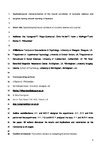Spatiotemporal neural characterization of prediction error valence and surprise during reward learning in humans
| dc.contributor.author | Fouragnan, Elsa | |
| dc.contributor.author | Queirazza, F | |
| dc.contributor.author | Retzler, C | |
| dc.contributor.author | Mullinger, KJ | |
| dc.contributor.author | Philiastides, MG | |
| dc.date.accessioned | 2018-05-15T14:28:06Z | |
| dc.date.available | 2018-05-15T14:28:06Z | |
| dc.date.issued | 2017-07-06 | |
| dc.identifier.issn | 2045-2322 | |
| dc.identifier.issn | 2045-2322 | |
| dc.identifier.other | 4762 | |
| dc.identifier.uri | http://hdl.handle.net/10026.1/11507 | |
| dc.description.abstract |
<jats:title>Abstract</jats:title><jats:p>Reward learning depends on accurate reward associations with potential choices. These associations can be attained with reinforcement learning mechanisms using a reward prediction error (RPE) signal (the difference between actual and expected rewards) for updating future reward expectations. Despite an extensive body of literature on the influence of RPE on learning, little has been done to investigate the potentially separate contributions of RPE valence (positive or negative) and surprise (absolute degree of deviation from expectations). Here, we coupled single-trial electroencephalography with simultaneously acquired fMRI, during a probabilistic reversal-learning task, to offer evidence of temporally overlapping but largely distinct spatial representations of RPE valence and surprise. Electrophysiological variability in RPE valence correlated with activity in regions of the human reward network promoting approach or avoidance learning. Electrophysiological variability in RPE surprise correlated primarily with activity in regions of the human attentional network controlling the speed of learning. Crucially, despite the largely separate spatial extend of these representations our EEG-informed fMRI approach uniquely revealed a linear superposition of the two RPE components in a smaller network encompassing visuo-mnemonic and reward areas. Activity in this network was further predictive of stimulus value updating indicating a comparable contribution of both signals to reward learning.</jats:p> | |
| dc.format.extent | 4762- | |
| dc.format.medium | Electronic | |
| dc.language | en | |
| dc.language.iso | eng | |
| dc.publisher | Springer Science and Business Media LLC | |
| dc.subject | Anticipation, Psychological | |
| dc.subject | Attention | |
| dc.subject | Avoidance Learning | |
| dc.subject | Brain | |
| dc.subject | Brain Mapping | |
| dc.subject | Choice Behavior | |
| dc.subject | Electroencephalography | |
| dc.subject | Female | |
| dc.subject | Humans | |
| dc.subject | Magnetic Resonance Imaging | |
| dc.subject | Male | |
| dc.subject | Nerve Net | |
| dc.subject | Reinforcement, Verbal | |
| dc.subject | Reward | |
| dc.subject | Young Adult | |
| dc.title | Spatiotemporal neural characterization of prediction error valence and surprise during reward learning in humans | |
| dc.type | journal-article | |
| dc.type | Journal Article | |
| dc.type | Research Support, Non-U.S. Gov't | |
| plymouth.author-url | https://www.webofscience.com/api/gateway?GWVersion=2&SrcApp=PARTNER_APP&SrcAuth=LinksAMR&KeyUT=WOS:000404841100018&DestLinkType=FullRecord&DestApp=ALL_WOS&UsrCustomerID=11bb513d99f797142bcfeffcc58ea008 | |
| plymouth.issue | 1 | |
| plymouth.volume | 7 | |
| plymouth.publication-status | Published online | |
| plymouth.journal | Scientific Reports | |
| dc.identifier.doi | 10.1038/s41598-017-04507-w | |
| plymouth.organisational-group | /Plymouth | |
| plymouth.organisational-group | /Plymouth/Faculty of Health | |
| plymouth.organisational-group | /Plymouth/Faculty of Health/School of Psychology | |
| plymouth.organisational-group | /Plymouth/REF 2021 Researchers by UoA | |
| plymouth.organisational-group | /Plymouth/REF 2021 Researchers by UoA/UoA04 Psychology, Psychiatry and Neuroscience | |
| plymouth.organisational-group | /Plymouth/Users by role | |
| plymouth.organisational-group | /Plymouth/Users by role/Academics | |
| plymouth.organisational-group | /Plymouth/Users by role/Researchers in ResearchFish submission | |
| dc.publisher.place | England | |
| dcterms.dateAccepted | 2017-05-17 | |
| dc.identifier.eissn | 2045-2322 | |
| dc.rights.embargoperiod | Not known | |
| rioxxterms.versionofrecord | 10.1038/s41598-017-04507-w | |
| rioxxterms.licenseref.uri | http://www.rioxx.net/licenses/all-rights-reserved | |
| rioxxterms.licenseref.startdate | 2017-07-06 | |
| rioxxterms.type | Journal Article/Review |


